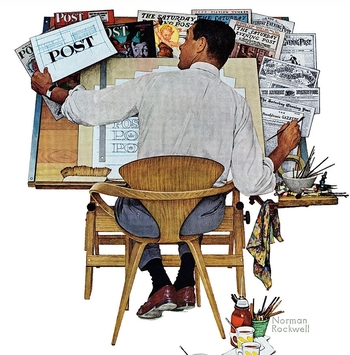Greenwich, Conn.
For a curator in search of a compelling exhibition, there's little better than a fresh, revealing storyline, a cast of artists both well-known and not, and art to substantiate the narrative. That's exactly what the Bruce Museum has in "Connecticut Modern: Art, Design, and the Avant-Garde, 1930-1960."
 "Big Bird" |
 "Ring Master" |
Installed loosely by theme and geography—clustering works by artists who lived near each other—the exhibition comprises nearly 85 works, photographs and documents. Calder, who moved to Roxbury in 1933 after many years in Paris, emerges as a connector and an innovator, with sculptures appearing throughout the show. He was already well-established but, in Connecticut, he gives nature a more prominent role in his works. Wanting to activate his mobiles, he harnessed the wind to move the colored discs of his outdoor, free-standing "Red, White, Black, and Brass" (1934). He devised the playful, red-and-black, seven-foot stabile "Big Bird" (1937) and "Yucca" (1941), whose sharp leaves are leavened by a mobile of small flowers floating above. And he created several snow mobiles, like "Roxbury Flurry" (1946), a gathering of flittering white discs inspired by a blizzard, poetically installed here against a blue-gray, winter-sky wall.
 "The Italian Straw Hat" |
Several artists acknowledge Calder, either inspired by him, as in David Hare's whimsical "Sun, Clouds, Mountain" (c. 1952) landscape sculpture, or referring to him. Peter Blume's painting "The Italian Straw Hat" (1952) intriguingly marries Surrealism with Precisionism and a dash of New England folk art—and incorporates both a Calder mobile and an old-style, made-in-Connecticut Hitchcock chair. And Paul Cadmus's crystalline "Inventor" (1946) includes a mobile of shells and feathers that, while never something Calder would have made, nonetheless pays him homage.
 "Artist At Work" |
Austin, who Mr. Silver says was one of "the essential links in the Connecticut visual arts network" (along with Calder and Breuer), is hardest to grasp. Not an artist, he comes through in documents and art made for him, including a catalog for his Surrealism show, "Newer Super-Realism" (1931), and Calder's funny, figurative collage (1936) thanking Austin for including him in the Atheneum's Hartford Festival. Pavel Tchelitchew, who lived in Weston, memorialized Austin wearing a red top hat and jacket over white trousers in a winsome watercolor, "Ring Master (Mr. Austin)" (1936), made for a museum gala. And Arshile Gorky, who on occasion stayed in the area, clearly perused the catalog for Austin's 1934 Picasso show. He bracketed the list of lenders (including Pierre Matisse and Averell Harriman) with two elongated figure drawings.
 "Sun, Clouds, Mountain" |
The value of "Connecticut Modern" goes beyond the artworks it displays. With its plentiful photographs, documents, cogent wall labels and catalog, it adds up to a sociological exposition as much as a visual one—and that's its real strength.

